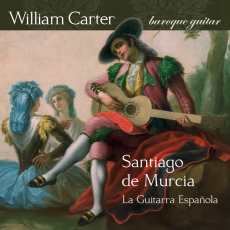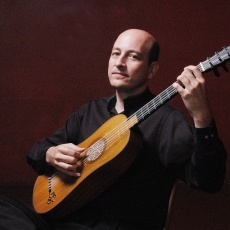Santiago de Murcia - William Carter - Atlanta Audio Society
Who was Santiago de Murcia, and why should we remember him? Well, he was born in Madrid (ca. 1682) to a family of musicians, and his music captures the spirit of an age in Spanish music. He was an accomplished Baroque composer, with a difference. That difference is that his music often reveals roots in the popular Spanish music of the day. As performed on a baroque guitar by William Carter of the Palladian Ensemble, these popular melodies and dances seem as fresh and vital today as if they were just written.
Santiago was a composer of polished technique, as revealed in his passacalles (a variation form) in common and triple time, his Suite after Gaspar Sanz, and his skillful transcription for guitar of Arcangelo Corelli's Violin Sonata, Op. 5, No. 3, in an arrangement that pays eloquent tribute to its source. But his genius shows as well in his pieces based on the popular dances of the day, such as the gallantly swaying Canarios (from the Canary Islands?) or the more sensually rhythmic Zarembecques, originally of West African origin by way of the New World. Some of these dances, such as the Chuchumbee (or Cumbees) were so sensual they even aroused the attention of the ecclesiastical authorities: "They are accompanied by lewd actions, lascivious displays, and indecent and provocative shaking," as one official reported to the Inquisition in 1716. And here we thought there was something new under the sun!
William Carter performs all these pieces on a baroque guitar, an instrument more limited in range - barely more than two octaves - than its modern counterpart, but with a very pleasing sound. "I do think," writes Carter, "that to look inward and explore the great wealth of colour and nuance within its small space is actually very rewarding." (Listen to the tender and intimate Marianos on Track 12, and you'll hear what he means). He is ably assisted by fellow Palladian Susanne Heinrich with plucked bass viol accompaniments in the Sanz suite, some of the Cumbees and Zarembecques, and the Corelli pieces, filling out the harmony and color. These performances all sound so vital, they successfully avoid the common pall of lifeless "authenticity."

